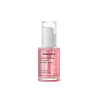What's inside
What's inside
 Key Ingredients
Key Ingredients

 Benefits
Benefits

 Concerns
Concerns

No concerns
 Ingredients Side-by-side
Ingredients Side-by-side

Water
Skin ConditioningGlycerin
Humectant1,2-Hexanediol
Skin ConditioningCetearyl Olivate
Squalane
EmollientSorbitan Olivate
EmulsifyingCarbomer
Emulsion StabilisingRetinol
Skin ConditioningCaprylic/Capric Triglyceride
MaskingHippophae Rhamnoides Fruit Extract
Skin ConditioningTromethamine
BufferingPhaseolus Radiatus Seed Extract
Skin ConditioningHydrogenated Lecithin
EmulsifyingInulin Lauryl Carbamate
Emulsion StabilisingSodium Polyacrylate
AbsorbentRetinal
Skin ConditioningHydrolyzed Sponge
Skin ConditioningAdenosine
Skin ConditioningSodium Hyaluronate
HumectantDisodium EDTA
Tocopheryl Acetate
AntioxidantPentaerythrityl Tetra-Di-T-Butyl Hydroxyhydrocinnamate
AntioxidantEthylhexylglycerin
Skin ConditioningRosmarinus Officinalis Leaf Extract
AntimicrobialPanthenol
Skin ConditioningMadecassoside
AntioxidantCentella Asiatica Extract
CleansingWater, Glycerin, 1,2-Hexanediol, Cetearyl Olivate, Squalane, Sorbitan Olivate, Carbomer, Retinol, Caprylic/Capric Triglyceride, Hippophae Rhamnoides Fruit Extract, Tromethamine, Phaseolus Radiatus Seed Extract, Hydrogenated Lecithin, Inulin Lauryl Carbamate, Sodium Polyacrylate, Retinal, Hydrolyzed Sponge, Adenosine, Sodium Hyaluronate, Disodium EDTA, Tocopheryl Acetate, Pentaerythrityl Tetra-Di-T-Butyl Hydroxyhydrocinnamate, Ethylhexylglycerin, Rosmarinus Officinalis Leaf Extract, Panthenol, Madecassoside, Centella Asiatica Extract
Collagen Water
HumectantWater
Skin ConditioningGlycerin
HumectantTripropylene Glycol
AntioxidantNiacinamide
SmoothingTrehalose
HumectantSodium Polyacryloyldimethyl Taurate
Emulsion StabilisingButylene Glycol
HumectantAllantoin
Skin ConditioningPolyglyceryl-10 Laurate
Skin ConditioningSodium Polyacrylate
AbsorbentEthylhexylglycerin
Skin ConditioningHydrolyzed Hyaluronic Acid
HumectantAdenosine
Skin ConditioningXanthan Gum
EmulsifyingPolyquaternium-51
Skin ConditioningDisodium EDTA
Glyceryl Acrylate/Acrylic Acid Copolymer
HumectantCaprylyl Glycol
EmollientPvm/Ma Copolymer
Emulsion StabilisingCyanocobalamin
Skin ConditioningCoptis Japonica Root Extract
Skin ConditioningSodium Hyaluronate
HumectantHydroxypropyltrimonium Hyaluronate
Tocopherol
AntioxidantPropanediol
SolventSaccharide Isomerate
HumectantSodium Acetylated Hyaluronate
HumectantCollagen Extract
Skin ConditioningHyaluronic Acid
HumectantHydrolyzed Sodium Hyaluronate
Skin ConditioningSodium Hyaluronate Crosspolymer
HumectantAlginic Acid
Skin ConditioningSilanetriol
Potassium Hyaluronate
Skin ConditioningHydrolyzed Elastin
EmollientElastin
Skin ConditioningSoluble Elastin
Skin ConditioningTripeptide-1
Skin ConditioningAcetyl Hexapeptide-8
HumectantCopper Tripeptide-1
Skin ConditioningPalmitoyl Tripeptide-5
Skin ConditioningSh-Oligopeptide-1
Skin ConditioningPentapeptide-4
Skin ConditioningPalmitoyl Tripeptide-38
Skin ConditioningHexapeptide-9
Skin ConditioningHexapeptide-12
Skin ConditioningPalmitoyl Pentapeptide-4
Skin ConditioningCollagen Water, Water, Glycerin, Tripropylene Glycol, Niacinamide, Trehalose, Sodium Polyacryloyldimethyl Taurate, Butylene Glycol, Allantoin, Polyglyceryl-10 Laurate, Sodium Polyacrylate, Ethylhexylglycerin, Hydrolyzed Hyaluronic Acid, Adenosine, Xanthan Gum, Polyquaternium-51, Disodium EDTA, Glyceryl Acrylate/Acrylic Acid Copolymer, Caprylyl Glycol, Pvm/Ma Copolymer, Cyanocobalamin, Coptis Japonica Root Extract, Sodium Hyaluronate, Hydroxypropyltrimonium Hyaluronate, Tocopherol, Propanediol, Saccharide Isomerate, Sodium Acetylated Hyaluronate, Collagen Extract, Hyaluronic Acid, Hydrolyzed Sodium Hyaluronate, Sodium Hyaluronate Crosspolymer, Alginic Acid, Silanetriol, Potassium Hyaluronate, Hydrolyzed Elastin, Elastin, Soluble Elastin, Tripeptide-1, Acetyl Hexapeptide-8, Copper Tripeptide-1, Palmitoyl Tripeptide-5, Sh-Oligopeptide-1, Pentapeptide-4, Palmitoyl Tripeptide-38, Hexapeptide-9, Hexapeptide-12, Palmitoyl Pentapeptide-4
 Reviews
Reviews

Ingredients Explained
These ingredients are found in both products.
Ingredients higher up in an ingredient list are typically present in a larger amount.
Adenosine is in every living organism. It is one of four components in nucleic acids that helps store our DNA.
Adenosine has many benefits when used. These benefits include hydrating the skin, smoothing skin, and reducing wrinkles. Once applied, adenosine increases collagen production. It also helps with improving firmness and tissue repair.
Studies have found adenosine may also help with wound healing.
In skincare products, Adenosine is usually derived from yeast.
Learn more about AdenosineDisodium EDTA plays a role in making products more stable by aiding other preservatives.
It is a chelating agent, meaning it neutralizes metal ions that may be found in a product.
Disodium EDTA is a salt of edetic acid and is found to be safe in cosmetic ingredients.
Learn more about Disodium EDTAEthylhexylglycerin (we can't pronounce this either) is commonly used as a preservative and skin softener. It is derived from glyceryl.
You might see Ethylhexylglycerin often paired with other preservatives such as phenoxyethanol. Ethylhexylglycerin has been found to increase the effectiveness of these other preservatives.
Glycerin is already naturally found in your skin. It helps moisturize and protect your skin.
A study from 2016 found glycerin to be more effective as a humectant than AHAs and hyaluronic acid.
As a humectant, it helps the skin stay hydrated by pulling moisture to your skin. The low molecular weight of glycerin allows it to pull moisture into the deeper layers of your skin.
Hydrated skin improves your skin barrier; Your skin barrier helps protect against irritants and bacteria.
Glycerin has also been found to have antimicrobial and antiviral properties. Due to these properties, glycerin is often used in wound and burn treatments.
In cosmetics, glycerin is usually derived from plants such as soybean or palm. However, it can also be sourced from animals, such as tallow or animal fat.
This ingredient is organic, colorless, odorless, and non-toxic.
Glycerin is the name for this ingredient in American English. British English uses Glycerol/Glycerine.
Learn more about GlycerinSodium Hyaluronate is hyaluronic acid's salt form. It is commonly derived from the sodium salt of hyaluronic acid.
Like hyaluronic acid, it is great at holding water and acts as a humectant. This makes it a great skin hydrating ingredient.
Sodium Hyaluronate is naturally occurring in our bodies and is mostly found in eye fluid and joints.
These are some other common types of Hyaluronic Acid:
Learn more about Sodium HyaluronateSodium Polyacrylate is the sodium salt of polyacrylic acid. It is used as an absorber, emollient, and stabilizer.
This ingredient is a super-absorbent polymer - meaning it can absorb 100 to 1000 times its mass in water. As an emollient, Sodium Polyacrylate helps soften and soothe skin. Emollients work by creating a barrier to trap moisture in. This helps keep your skin hydrated.
Water. It's the most common cosmetic ingredient of all. You'll usually see it at the top of ingredient lists, meaning that it makes up the largest part of the product.
So why is it so popular? Water most often acts as a solvent - this means that it helps dissolve other ingredients into the formulation.
You'll also recognize water as that liquid we all need to stay alive. If you see this, drink a glass of water. Stay hydrated!
Learn more about Water